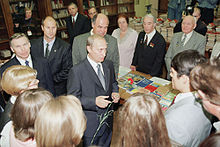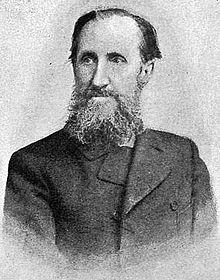- Moscow State Pedagogical University
-
Moscow State Pedagogical University Московский педагогический государственный университет 
Old main building, in Malaya PirogovskayaEstablished 1872, 1918 Type Public Students 20,000 Location  Moscow, Russia
Moscow, RussiaWebsite http://www.mpgu.edu/ The Moscow State Pedagogical University, previously known as the Moscow University for Women, the Second Moscow State University, the Moscow State Pedagogical Institute and the Moscow State V. I. Lenin Pedagogical Institute, and with origins dating back to 1872, is a major educational and scientific institution in Moscow, Russia, with eighteen faculties and seven branches in other Russian cities.
History
The university originates in Guerrier's Higher Women's Courses, founded in 1872, and was subsequently reconstituted several times. In 1918 it admitted men and became the Second Moscow State University, then was reformed without its Medical and Chemical Technology schools as the Moscow State Pedagogical Institute, which for a time was known as the Moscow State V. I. Lenin Pedagogical Institute. In 1990, the Institute regained the status of university and thus its present name.
Guerrier Courses (1872–1888)
In May 1872 the Russian Minister of Education, Count Dmitry Tolstoy, consented to the opening by Professor V. I. Guerrier of "Higher Women's Courses" as a private educational institution and approved Regulations for this purpose. In November 1872, the first building of the Moscow Higher Women's Courses was opened at Volkhonka, ushering in the era of higher education for women in Russia.[1]
Initially, courses were for two years and were in both humanities and natural sciences. At first, there were two departments, History & Philology and Physics & Mathematics. In Moscow alone, 1,232 women were admitted to the courses between 1872 and 1886.[2]
A female student attending a course became known as a kursistka. While still a young doctor, Anton Chekhov paid for his sister Masha to attend Guerrier courses.[3]
In 1886, the Ministry of Education prevented the admission of new students to Guerrier's courses, and they ended in 1888.
Public Lectures and Collective Lessons (1888–1900)
Following the end of the Guerrier courses, Public Lectures for women were organized systematically, most of them given by the same teachers, and in the same premises, as before. The Public Lectures lasted until 1892, when they were closed by the government. From 1886 there were also Collective Lessons, with a bias towards the natural sciences.
Moscow Higher Women's Courses, or Moscow University for Women (1900–1918)
In 1900 the title of Moscow Higher Women's Courses was instituted, and in 1906 a School of Medicine was launched. Courses were taught by outstanding scholars. In 1907, educational buildings by the architect Soloviev opened in Little Tsaritsyn Street, now Small Pirogovskay Street. This is now the main building of the Moscow State Pedagogical University. In 1908 came the Anatomical Theatre, now the Russian State Medical University, and the Physical Chemistry Building, now the Moscow Academy of Fine Chemical Technology.
In 1915-1916, the Moscow Higher Women's Courses, sometimes called the Moscow University for Women, received the right of issuing diplomas. By 1918, the institution had 8,300 thousand students and in numbers was second only to the Moscow State University.
Second Moscow State University (1918–1930)
In 1918, the University was renamed the Second Moscow State University and was often called also the Second Moscow University, beginning to admit men as well as women.[4][5][6]
During this period, the staff of the University included Dmitri Ivanovich Sakharov, the father of Andrei Sakharov.[7]
From 1926, the University included a Department of Yiddish Language and Literature, the primary purpose of which was to train teachers for the Soviet Union's Yiddish language primary and secondary schools.[8]
In 1927, day care nurseries for the children of students were in place, and in 1928 new buildings to provide accommodation for 1,000 students were built at a cost of one million Roubles.[9]
From 1924 to 1930, the University's rector was Albert Petrovich Pinkevich, an important educationist and author of The New Education in the Soviet Republic, who became a victim of Stalin's Great Purge, "disappearing" in 1937 to a Gulag labour camp.[10]
Moscow State Pedagogical Institute (1930–1941)
In 1930, the Second Moscow University was divided into three separate institutions: the Second Moscow State Medical Institute (now the Russian State Medical University; the Moscow State Institute of Fine Chemical Technology (now the Moscow State Academy of Fine Chemical Technology) and the Moscow State Pedagogical Institute, based on the teaching faculty.
By the mid 1930s the Yiddish department, now part of the Institute and headed by Meir Wiener, had become one of the world's leading centres of Yiddish scholarship.[8]
Moscow State V. I. Lenin Pedagogical Institute (1941–1960)
For a time, the Institute took the name of Lenin. In 1960 it was combined with the Moscow City Pedagogical Institute.
Moscow State Pedagogical Institute
In 1967, a Western writer on Russia called the Institute "...probably the most prestigious pedagogical institute in the USSR". Its student body then numbered 10,500.[11]
Moscow State Pedagogical University (since 1990)
The Institute regained the title of a University in 1990. In the year 1996-97, it had 12,000 students and six hundred teaching staff with the title of professor. A Bachelor's degree was awarded after four years of academic study, a teaching qualification after five years.[12]
The Seventh International Bakhtin Conference took place at the University in June, 1995.[13]
Present day
 Vladimir Putin visits the University's Library in September 2001
Vladimir Putin visits the University's Library in September 2001
The University now has eighteen faculties and 103 departments, some 20,000 students, and an active faculty of 225 professors and over nine hundred assistant professors. Seventeen staff members are full and corresponding members of the Russian Academy of Sciences and the Russian Academy of Education.[14]
The Prometei publishing house, of Moscow, sometimes spelt Prometey, is attached to the University.[15]
Notable alumni
- Veronika Dolina, songwriter
- Nikolay Glazkov, poet
- Raisa Gorbachova, the wife of Mikhail Gorbachev[16]
- Vadim G. Gratshev, paleoentomologist
- Yuliy Kim, author
- Albert Muchnik, mathematician
- Roman Personov, physicist
- Lev Razgon, writer and the Memorial Society co-founder
- Alexey Venediktov, journalist
- Yuri Vizbor, actor and poet
- Dmitry Vodennikov, author
Notable staff
- Viktor Idzio, historian
- Otto Schmidt, astronomer and member of the Supreme Soviet of the Soviet Union[17]
- Eduard Shpolsky, physicist
- Igor Tamm, winner of the Nobel Prize in Physics of 1958[18]
- Alexander Tubelsky, historian and university administrator
See also
- List of modern universities in Europe (1801–1945)
External links
- Official web site (in Russian)
References
- ^ Alexander Vucinich, Science in Russian culture (1963), p. 53: "Encouraged by this development, Professor V I Guerrier of Moscow University obtained permission to institute a program known as the Higher Courses for Women."
- ^ Christine Johanson, Women's struggle for higher education in Russia, 1855-1900 (1987), p. 107 online at books.google.co.uk
- ^ Carolina de Maegd-Soëp, Chekhov and women: women in the life and work of Chekhov (1987), p. 101
- ^ Nikolai Krementsov, The Cure: a Story of Cancer and Politics from the Annals of the Cold War (2004), p. 218
- ^ Lyn D. English, Maria G. B. Bussi, Handbook of international research in mathematics education (2008), p. 650
- ^ London Mathematical Society, Russian mathematical surveys, Volume 20, Issues 1-3 (1965), p. 22: "The Second Moscow University, founded on the basis of the Advanced Lectures for Women, was subsequently reconstituted as the V. I. Lenin Pedagogical Institute".
- ^ Sidney David Drell, Sergeǐ Petrovich Kapitsa, Sakharov Remembered: a tribute by friends and colleagues (1991), p. 4
- ^ a b Mikhail Lev, Sobibor: a documentary novel of the Sobibor uprising (2007), p. xi
- ^ Soviet Union Information Bureau, Soviet Union Review, volumes 5-7 (1927), p. 159
- ^ William Hale Wilbur, Russian Communism: a challenge and a fraud (1964), p. 26
- ^ Herbert Charles Rudman, The school and state in the USSR (1967), p. 122
- ^ Jan de Groof, Gracienne Lauwers, A new framework of special education in the Russian Federation (2000), p. 55 online at books.google.co.uk, accessed 4 November 2010
- ^ Monika Greenleaf, Stephen Moeller-Sally, Russian subjects: empire, nation, and the culture of the Golden Age (1998), p. 371
- ^ Moscow State Pedagogical University page at mathnet.ru, accessed 2 November 2010
- ^ Rosalind J. Marsh, Gender and Russian literature: new perspectives (1996), p. 283
- ^ Robert P. Watson, Raisa Maximovna Gorbachev, in The Presidents' Wives: Reassessing the Office of First Lady (2000), p. 9 online at books.google.co.uk
- ^ Aleksey E. Levin, Stephen G. Brush, The origin of the solar system: Soviet research, 1925-1991 (1995), p. 9
- ^ Evgeniĭ Lʹvovich Feinberg, Reminiscences about I. E. Tamm (1987)
Categories:- Universities in Moscow
- Education schools
- Educational institutions established in 1872
Wikimedia Foundation. 2010.


